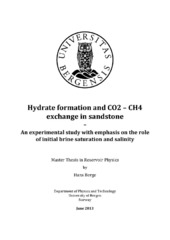| dc.description.abstract | Recent research activity has demonstrated the viability of producing methane from gas hydrate bearing sediments by injecting and sequestering CO2 in a process where CO2 replace methane in gas hydrate by a process called CO2 - CH4 exchange. The work presented in this thesis consist of a series of ten experiments designed to increase the basic knowledge of hydrate formation and subsequent methane production by CO2 - CH4 exchange in sandstone with emphasis on the effect of initial water saturation and brine salinity. Methane hydrate was formed at 8.3 MPa and 4 °C in ten partially saturated Bentheimer sandstone cores with varying initial water saturation and salinities. The hydrate formations were reproducible and showed a strong correlation between hydrate growth rate and both salinity and water saturation, where increased salinity or water saturation resulted in slower formation and more residual water. A correlation between initial growth rate and hydrate saturation were observed where the change in growth rate were proportional to the change in saturation. Hydrate bearing sandstone core plugs with high residual water saturation were successfully obtained by using initial water saturation above 0.6. CO2 - CH4 exchange was successfully performed on five hydrate bearing core plugs with different hydrate and water saturations. CO2 - CH4 exchange were performed by injecting liquid CO2 and a 75 mol% N2 + 25 mol% CO2 mix at a rate of 0.02 ml/min and measuring the effluent composition with a GC and, for some cores, the mass flow with a mass flow meter. The highest methane recovery from hydrate was estimated at 52%. Nitrogen was successfully used to dissolve plugging in two experiments without any resulting large scale dissociation. Co-injection of nitrogen and carbon dioxide showed excellent ability to hinder secondary hydrate formation during exchange without affecting the recovery. One experiment was conducted by performing repeated formations and dissociations on the same core. There was observed a significant increase in formation rate when the pressure was maintained between dissociation and formation, and a significant increase in dissociation rate when the time between formation and dissociation were long. | en_US |
